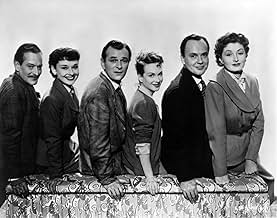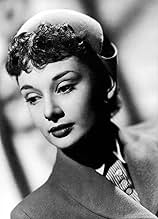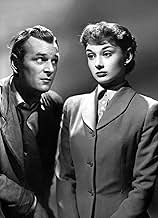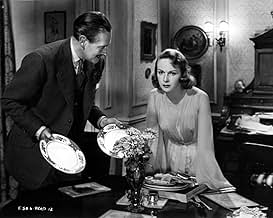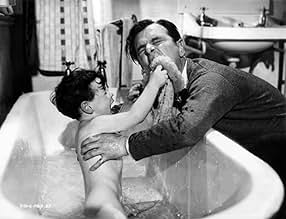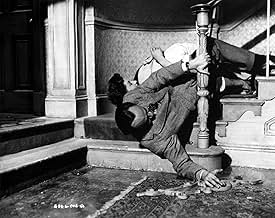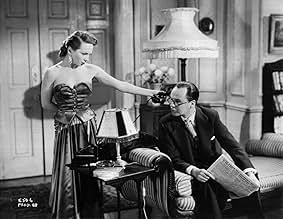Agrega una trama en tu idiomaA post-war housing crisis leaves a shy woman to share a house with two couples. Comic situations arise as the new lodger becomes infatuated with one of the husbands.A post-war housing crisis leaves a shy woman to share a house with two couples. Comic situations arise as the new lodger becomes infatuated with one of the husbands.A post-war housing crisis leaves a shy woman to share a house with two couples. Comic situations arise as the new lodger becomes infatuated with one of the husbands.
- Valentine
- (sin créditos)
- Ayah
- (sin créditos)
- Nanny
- (sin créditos)
- Man in Pub
- (sin créditos)
- Elizabeth
- (sin créditos)
- Cab Driver
- (sin créditos)
- Man in Pub
- (sin créditos)
- Young Girl
- (sin créditos)
- Nurse
- (sin créditos)
- Dirección
- Guionistas
- Todo el elenco y el equipo
- Producción, taquilla y más en IMDbPro
Opiniones destacadas
Sabina is a former actress now a young housewife married to writer Rodney.
Meanwhile both Mary and her sedate husband Bruce go out to work.
It leaves Sabina to look after the house and cook for them all. There is a nanny that cares for the children but she leaves when Bruce is rude to her.
To remedy the situation, Mary quickly finds a replacement and this time they pass both the kids off as siblings.
Later for some unfathomable reason. Sabina ends up kissing two men, one of them being Bruce.
This annoys both Mary and Rodney who ends up kissing lovelorn lodger Eve (Audrey Hepburn.)
This is a middle class farce that is not funny and very much of its time. It is very sedate probably due to the censorship laws of the time.
I had no idea why Sabina ended up kissing the other men and I expected both Mary and Rodney to be enraged.
There was no social commentary here. The house was spacious when it was meant to demonstrate the post war housing crisis.
Sabina was not much of a housewife, unable to cook for four adults when she had a nanny to mind the kids.
Also, for serious buffs, the cinematographer was the great Erwin Hillier who worked with F.W. Murnau on 'Tabu', with Fritz Lang on 'M', and with Powell and Pressburger on 'A Canterbury Tale' and 'I Know Where I'm Going', and many other major movies.
The film is set in the years immediately following World War II, when Britain was suffering from a serious housing shortage. Many houses had been destroyed during the war, and the country had neither the manpower nor the financial resources to start building new ones. The film centres upon the efforts of two young married couples, Bruce and Mary and Rodney and Sabina, to overcome the shortage by sharing a house. As the house is also occupied by two young children, a live-in nanny and a young female lodger (Hepburn's role), it would probably today be classed as statutorily overcrowded, but in the late fifties and early fifties nobody seemed to worry about that.
Some attempt is made to differentiate between the personalities of the two couples. Bruce and Mary are both staid, conventional bourgeois types, working in nine-to-five jobs. Rodney and Sabina are more bohemian; he is a writer, and she a former actress, although she has given up the stage in order to be a housewife and mother to their young son, even though she seems to lack domestic skills entirely. Perhaps because her character is an ex-actress, Joan Greenwood gives a rather odd performance in the role, making Sabina the sort of actress who constantly overacts, even when she is away from the stage, and delivering even the most commonplace of lines with exaggerated dramatic intensity. (If this is what Sabina is like in her private life, I would have hated to see any of her stage performances).
Most of the humour (or perhaps I should say attempts at humour) derives from Bruce and Mary's struggles to retain the services of a nanny or from various mix-ups and misunderstandings to do with sex. This being the early fifties, however, the scriptwriters have to proceed on the basis of "nudge, nudge, wink, wink" rather than being explicit about what they actually mean. The film is based on a stage play (which I have never seen), but today it comes across as a sort of over-extended episode of a seventies domestic sitcom. Whatever humour it once possessed seems to have evaporated with the passage of over seventy years, and today it just doesn't come across as funny. Its only appeal today will probably be to Hepburn completists, and even they are likely to be disappointed at the revelation that not every film in which their idol appeared was a "Roman Holiday", "The Nun's Story" or "Breakfast at Tiffany's". 4/10.
The only reason to watch it is to see Audrey Hepburn's. First featured role. It's not a big part but,. Her Star quality is obvious to all. You can see why, just over two years later, she had an Oscar on her shelf.
¿Sabías que…?
- TriviaMavis Sage's debut.
- ErroresAt the start when Joan Greenwood takes the washing from the line to the house, the basket is overflowing and untidy. When she enters the house the items are neatly tucked inside the basket she is carrying.
- Citas
Nanny: Stop following me, young woman or I'll call a park keeper and give you in charge.
Mary Banning: But Nanny, I'm simply putting a business proposition to you.
Nanny: Ah. I've heard about girls being tempted by strangers. With promises of high wages and an easy life. How many of them have ever been seen again?
- Créditos curiososOpening and closing credits are presented on towels hanging on a washing line.
- ConexionesFeatured in Audrey Hepburn Remembered (1993)
Selecciones populares
- How long is Young Wives' Tale?Con tecnología de Alexa
Detalles
- Fecha de lanzamiento
- País de origen
- Idioma
- También se conoce como
- Mit Küchenbenutzung
- Locaciones de filmación
- Productora
- Ver más créditos de la compañía en IMDbPro
- Tiempo de ejecución1 hora 19 minutos
- Color
- Relación de aspecto
- 1.37 : 1

